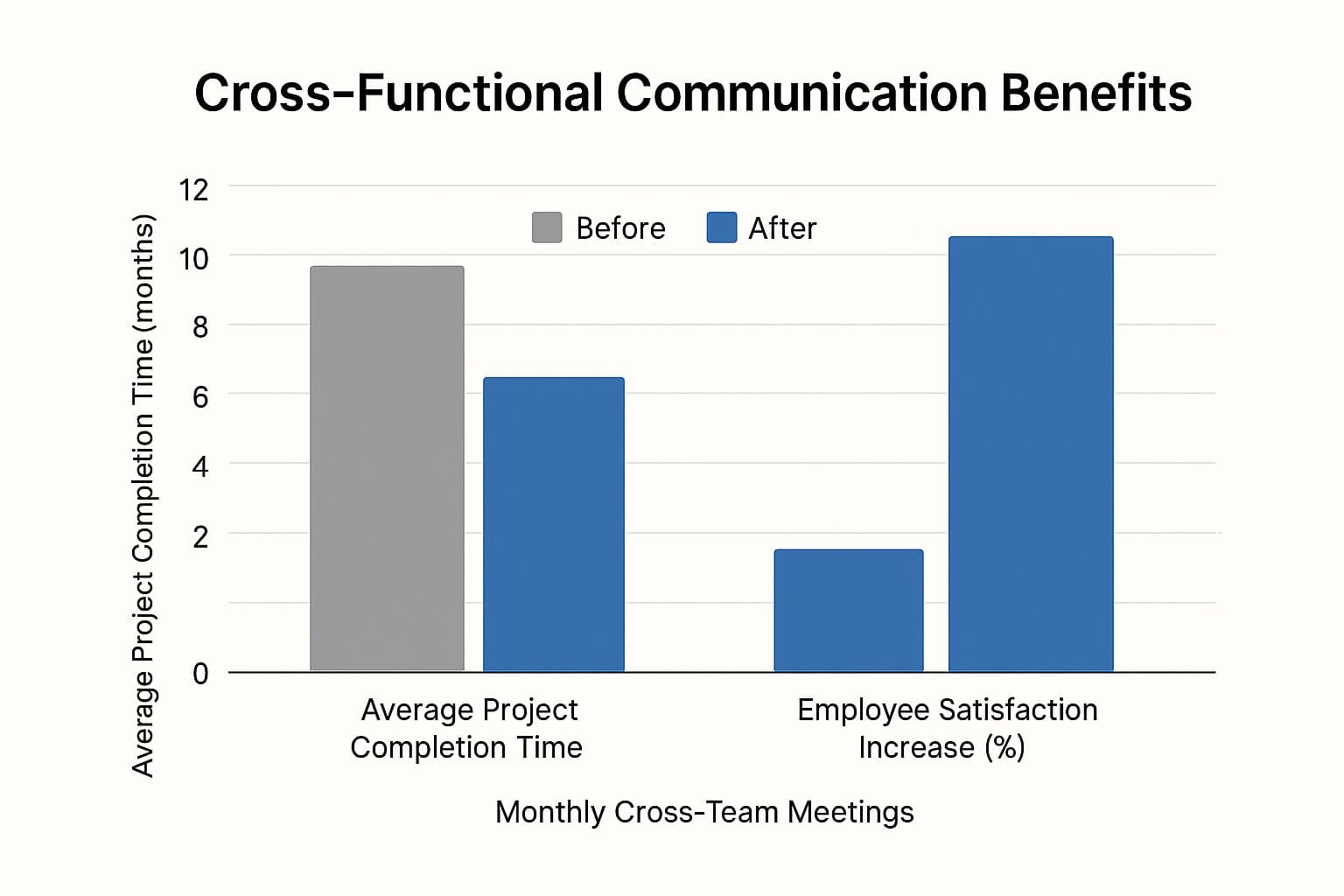Let's be honest, we've all seen it happen. The marketing team launches a campaign for a feature that engineering hasn't even finished building. Or sales promises a delivery date that makes the logistics team's heads spin. These are classic symptoms of a business working in silos.
Cross-functional communication is the cure. It’s simply how people from different teams—like marketing, engineering, and sales—talk to each other, share information, and work together on the same goals.
What Is Cross-Functional Communication?
Think of it like building a house. You have plumbers, electricians, carpenters, and painters all working on the same project. If they don't communicate, you'll end up with a light switch behind a cabinet or pipes where a wall should be. It would be a disaster.
Cross-functional communication is the blueprint everyone shares. It’s the ongoing conversation that ensures the electrician knows where the plumber is running pipes, and the painter knows which walls are ready for color. It connects all these specialized experts so they can build something great, together.
This isn't just about scheduling more meetings. It’s about creating a culture where a customer support rep’s insight can spark an idea for an engineer, or where a salesperson’s feedback directly shapes the next marketing message. It’s about making sure every individual effort adds up to something bigger.
The Secret to Staying Agile
In today's market, you have to be able to pivot and adapt quickly. Strong cross-functional communication is what makes that possible. It's the foundation of business agility, allowing companies to solve tough problems and jump on new opportunities before the competition does.
When different teams are truly in sync, you start to see real magic happen:
- Smarter Innovation: You get better ideas when you mix perspectives. A designer, a coder, and a marketer will spot problems and solutions that no single one of them would see alone.
- Less Wasted Effort: It cuts down on redundant work. The product team won't spend weeks researching a feature that the sales team already knows customers don't want.
- Happier, More Engaged People: When employees see how their work connects to the bigger picture and feel part of a united team, they're more invested and motivated.
The numbers don't lie. Recognizing the need to stay nimble, 83% of companies now rely on cross-functional teams. But there's a catch: a massive 97% of employees say that when these teams aren't aligned, it hurts the project's outcome. You can dig into more of these collaboration stats on 9cv9's blog.
This just goes to show how crucial it is to nail communication. It’s what separates a company firing on all cylinders from one where the wheels are just spinning.
Why Departmental Silos Quietly Sabotage Growth
Departmental silos are the silent killers of business growth. Think of each team—marketing, engineering, sales—as its own little island. They have their own language, their own goals, and they're laser-focused on their own turf, often hoarding information and resources.
On the surface, this might seem fine. But this isolation is where inefficiency starts to fester. When information doesn’t flow freely between these islands, teams end up duplicating work, blowing past critical deadlines, and creating internal friction that can bring company-wide progress to a grinding halt.
The Real-World Cost of Disconnection
This isn't just some abstract management theory; it has very real, tangible consequences. Picture this: the marketing team launches a brilliant campaign for a new product feature, completely unaware that engineering, working in their own bubble, just pushed the release date back a month.
Or maybe a salesperson promises a custom solution to land a huge client, having no idea that the operations team is already stretched thin and can't possibly deliver on that timeline. These aren't small slip-ups. They lead to frustrated customers, demoralized employees, and a brand reputation that takes a serious hit.
The financial fallout from this kind of poor communication is staggering. It's estimated that U.S. businesses lose 1.2 trillion** every single year from these hidden costs, which works out to about **12,506 lost per employee. On the flip side, companies where leaders prioritize communication see productivity soar by 72%.
The table below breaks down just how stark the difference is between a collaborative environment and a siloed one.
The Impact of Strong vs Weak Cross Functional Communication
| Metric | Strong Communication Outcome | Weak Communication Outcome |
|---|---|---|
| Project Velocity | Projects are completed faster with fewer revisions and roadblocks. | Deadlines are frequently missed due to rework and misaligned efforts. |
| Innovation | New ideas emerge from the intersection of different perspectives. | Ideas stagnate within teams, leading to a lack of creative solutions. |
| Employee Morale | Teams feel connected to a larger purpose, boosting engagement and retention. | Frustration and blame culture take hold, leading to high turnover. |
| Customer Satisfaction | Customers receive a cohesive, positive experience at every touchpoint. | The customer experience is disjointed and inconsistent, causing churn. |
| Resource Allocation | Budgets and staffing are used efficiently on shared, high-priority goals. | Resources are wasted on duplicated work and competing internal priorities. |
As you can see, the way your teams talk to each other—or don't—directly impacts everything from your product to your people.

This data clearly shows that when you improve cross functional communication, you don't just get warmer feelings around the office. You get faster project delivery and a real boost in employee satisfaction.
How Silos Erode Company Culture
Beyond the balance sheet, departmental silos are toxic to your company culture. When teams develop an "us vs. them" mindset, trust evaporates, and collaboration starts to feel like a chore. This toxic environment quietly sabotages your long-term success in a few key ways.
- Blame Games: When a project inevitably goes sideways, fingers start pointing across departments instead of people coming together to actually solve the problem.
- Reduced Innovation: Real breakthroughs often happen when different perspectives collide. Silos prevent this creative friction, leaving you with stale products and outdated processes.
- Employee Disengagement: Good people want to see how their work contributes to the bigger picture. If they feel cut off from the company's mission, their motivation and loyalty quickly fade.
Ultimately, these communication breakdowns create a vicious cycle of inefficiency and low morale. Information gets lost in translation, projects get delayed, and teams spend more time navigating internal politics than they do serving customers. That's precisely why learning how to run effective team meetings that drive results is such a crucial first step.
Once you connect the dots between poor communication and its impact on the bottom line, it becomes crystal clear that tearing down those walls isn't just a nice idea—it's essential for survival and growth.
Building Bridges: A Practical Framework for Cross-Functional Success
It's one thing to point out the problems silos cause, but it's another thing entirely to fix them. Just telling your teams to "collaborate more" is like handing a mechanic a pile of engine parts and expecting them to build a car—there are no instructions. To really make a difference, you need a solid framework built on three key pillars: shared goals, clear processes, and the right tools.
This approach transforms your company from a bunch of separate islands into a connected ecosystem. It provides the structure that lets information flow freely and gets everyone pulling in the same direction. Without it, even the best intentions can get lost in confusion and missed deadlines.

Unify Teams with Shared Goals
The fastest way to tear down silos is to give everyone the same destination on their GPS. When different teams have conflicting priorities, they naturally work against each other. A shared goal acts as a North Star, making sure every single department is rowing in the same direction.
A fantastic way to do this is with Objectives and Key Results (OKRs). OKRs push teams to think bigger than just their own daily tasks. For instance, a company-wide goal to "Increase Customer Loyalty" isn't something the support team can tackle alone.
- Marketing has to run campaigns that attract and keep the right kind of customers.
- Engineering needs to build a product that's stable and a joy to use.
- Sales must set the right expectations from the very first conversation.
When each department’s key results feed into the same big objective, collaboration becomes a necessity, not just a nice-to-have. This is huge, especially when you consider that a whopping 75% of cross-functional teams fail because of unclear missions and competing agendas.
Clarify Roles and Processes
Once you're all aiming for the same target, you need to figure out who’s doing what. Ambiguity is the enemy of teamwork. If nobody knows who's responsible for a task, things inevitably fall through the cracks, and the whole project grinds to a halt.
This is where a RACI chart comes in handy. It's a simple but incredibly effective tool for adding clarity. For every task, it clearly defines who is:
- Responsible (the person doing the work)
- Accountable (the single person who owns the outcome)
- Consulted (people who need to provide input)
- Informed (people who just need to be kept updated)
This little matrix gets rid of the "I thought you were doing that" problem before it even starts.
Beyond just assigning roles, you need to establish a good communication rhythm. This means setting up regular check-ins between departments that are focused and productive. These meetings shouldn't just be status updates; they should be active working sessions to solve problems and coordinate the next steps.
Equip Teams with the Right Tools
Finally, even the best plans will fail if your teams don’t have a shared digital space to work in. The right technology acts as the central nervous system for your whole operation, connecting people and information no matter where they sit.
Your essential toolkit should include:
- Project Management Software: You can't live without tools like Asana, Trello, or Jira. They create a single source of truth for who’s doing what, by when, so everyone can see the big picture.
- Knowledge Hubs: A central library like Confluence or Notion is a game-changer. It stops important documents and notes from getting buried in endless email chains or trapped on someone's hard drive.
- Communication Platforms: Real-time chat tools like Slack or Microsoft Teams are crucial for quick questions and daily problem-solving, keeping everyone on the same page.
By putting these tools in place, you create an environment where sharing information is second nature. This lets your teams stop wrestling with logistics and start focusing on what really matters: innovating and working together.
Connecting Clear Goals to Revenue Growth

Let's be clear: effective cross-functional communication isn't just a "nice-to-have" skill. It’s a hard-hitting business strategy with a very real impact on your bottom line. The logic is simple but powerful. When teams know why they're doing what they're doing and can see how their work connects to other departments, everything clicks into place.
Productivity shoots up. Engagement skyrockets. Suddenly, communication isn't just about sending emails—it’s the engine driving your company’s growth.
The foundation for all of this? Clear, shared goals. When everyone is rowing in the same direction, collaboration stops being a chore and starts happening naturally. It gets rid of the departmental turf wars and conflicting priorities that can sink even the best-laid plans.
From Alignment to Financial Impact
This kind of alignment pays off in real dollars and cents. A global survey of knowledge workers revealed that 55% of respondents saw significant revenue growth in companies with strong cross-departmental collaboration. The data draws a straight line between clear goals and great teamwork.
Consider this: a staggering 71% of employees who had clearly defined goals said working with other departments was easy. For those with unclear goals, that number plummeted to just 26%. You can dive deeper into the numbers in this study on cross-functional business growth.
The takeaway is obvious. Fuzzy goals lead to confusion and friction, making it a struggle for teams to work together. But when goals are crystal clear and shared by everyone, they act as a unifying force, making teamwork feel effortless and directly boosting the company's financial performance.
Think about a major product launch. It's the ultimate test of teamwork, demanding perfect sync between departments to pull it off.
Product Launches: A Case Study in Collaboration
A successful launch is like a well-conducted symphony. Every department has a crucial part to play, and if one is out of tune, the whole performance can fall flat.
Here’s how clear, shared goals make all the difference:
- Product Team: They’re building features based on a deep, shared understanding of what customers actually want, fed directly from sales and support. No more wasting time on features that miss the mark.
- Marketing Team: They create messaging that truly reflects the product's value. This means no overpromising and no targeting the wrong people.
- Sales Team: They go into conversations confident and well-informed, able to answer tough questions and close deals because they trust the product team will deliver.
- Customer Support: They’re not caught off guard. They have the documentation and training they need before launch, ready to help new customers hit the ground running.
When these teams operate from the same playbook, the entire customer experience feels seamless. This doesn't just make customers happier; it builds loyalty and gets you to profitability faster. The launch goes smoother, more people adopt the product, and revenue climbs—proving that great communication is one of the smartest investments you can make.
Using AI to Enhance Team Collaboration
Even when you have a solid game plan, meetings are often where things fall apart. They're the weak link in the cross-functional communication chain—the exact spot where alignment shatters, momentum dies, and good projects start to go sideways.
The core problem is simple but incredibly destructive. When a key stakeholder from sales misses a critical engineering sync, the whole timeline can be thrown off. When marketing and product teams walk out of the same room with completely different ideas about what’s next, you’re already in trouble. This kind of information loss is the silent saboteur of collaboration.
Overcoming Information Loss with Technology
This is where technology can step in and make a real difference. AI meeting summarization tools are built to tackle this exact problem. Think of them as a digital safety net, catching every important detail so nothing gets lost.
Imagine a world where every important conversation is automatically captured and saved. These tools don't just record meetings. They transcribe every word, figure out who said what, and then use AI to pull out the most important points into a clean, accurate summary.
For example, a busy executive can catch up on a two-hour planning session in just five minutes. Or an engineer joining a project late can get up to speed instantly just by reading through the summaries of past meetings.
A Strategic Asset for Alignment
This isn't just about making life easier; it's a real strategic advantage. By creating one reliable record of what happened, these AI tools get rid of the "he said, she said" arguments and misunderstandings that cause so much friction between teams.
Here’s how they directly strengthen collaboration:
- Total Accountability: Every action item is automatically assigned and written down. There’s zero confusion about who owns what, which is crucial for keeping projects on track.
- Seamless Onboarding: New team members can get the full project history and context on their own time, without having to pull people away from their work for long debriefs.
- Enhanced Focus: When everyone knows the meeting is being transcribed and summarized, they can actually participate in the conversation instead of just trying to scribble down notes.
- Global Team Synchronization: For remote or distributed teams spread across different time zones, these summaries are a lifeline. They keep everyone perfectly aligned, no matter when they work.
Tools like Summarize Meeting take messy, chaotic conversations and turn them into structured, actionable information. They make sure that every department—from marketing and sales to engineering and support—is working from the exact same playbook. This transforms meetings from a potential source of confusion into a powerful engine for unified action, ensuring every team member is on the same page and pushing toward the same goals.


